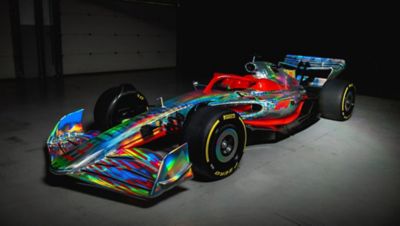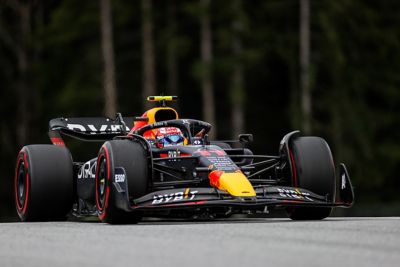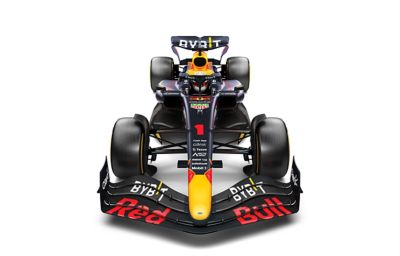-
-
Access Free Student Software
Ansys empowers the next generation of engineers
Students get free access to world-class simulation software.
-
Connect with Ansys Now!
Design your future
Connect with Ansys to explore how simulation can power your next breakthrough.
Countries & Regions
Free Trials
Products & Services
Learn
About
Back
Products & Services
Back
Learn
Ansys empowers the next generation of engineers
Students get free access to world-class simulation software.
Back
About
Design your future
Connect with Ansys to explore how simulation can power your next breakthrough.
Free Trials
ANSYS BLOG
October 20, 2022
Simulation Gives Oracle Red Bull Racing an Edge in the Transformed World of Formula One
At the start of the 2022 season, Formula One racing was completely transformed. With an entirely new set of design guidelines introduced by Formula One and the FIA — the sport’s governing body — for the 2022 racing season, the cars look completely different. Even more exciting for F1 fans? The cars perform differently.
A host of design changes were created by the FIA with a single goal in mind: creating a more competitive and exciting racing environment. And that’s certainly happened. Today’s new car designs have dramatically increased the ability of F1 drivers to closely follow the car in front of them, giving them a platform to launch an overtake, especially on tight, technical tracks where cars historically struggled.
Consider the difference we’ve seen so far this season. In Monaco, there were no overtakes at all in 2021; this season there were 12. At the Hungaroring in Hungary, overtakes increased from 17 in 2021 to an impressive 65 in 2022.

As a racing fan, I’m thrilled by the radical new design guidelines. But, as someone who works closely with engineers every day, I understand the depth and breadth of the challenges they’ve created for Formula One teams, including Oracle Red Bull Racing — which has been an Ansys partner since 2008. After winning the 2021 Formula One Constructors Championship with star driver, Max Verstappen, behind the wheel, the team’s engineers had to start the 2022 season with a virtual blank slate.

Three Big Changes Are Fueling More Exciting Race Day Results
What exactly has changed?
“The overhaul of Formula One’s technical regulations for 2022 is so extensive that it’s easier to list the parts of the car that aren't changing than the parts that are,” wrote ESPN F1 editor, Laurence Edmonson, when he previewed the design transformation back in January. There’s no doubt that the 2022 cars have a totally new look and feel.
Let’s take a quick look at three big design changes impacting car design and how Ansys simulation solutions helped the Oracle Red Bull Racing team maintain its engineering advantage as it geared up for the 2022 racing season.

Redesigned Front Wing and Nose Concepts
Let’s start with one of the most obvious design changes: Formula One cars now have a completely different front end.
With any F1 car design, it is extremely difficult for any car to overtake the car in front of it because every car has the same highly aerodynamic design that depends on consistent flows around the front end. But the previous F1 generation was designed to be “outwashing” — that is, it produced a “dirty wake” and a large vortex structure that disturbed the airflow encountered by following cars. As a result, the following car would lose about half of its downforce. This influx of “dirty air” led to a loss of speed and cornering precision. The significant loss of downforce dramatically decreased the possibility of overtaking, especially at certain F1 tracks.
The new front wing and nose concepts defined by the FIA have leveled the playing field by radically changing the influence they have on the other parts of the car. These design changes, combined with new designs of the floor and wheels, result in a different approach to downforce production in the car underbody. Engineers no longer need to ensure that the airflow in the front wheel wake is sent outboard (outside the body of the car); the air is now pushed through the car’s body to create downforce. This decreases the overall influence of the leading car wake on the overtaking car’s aerodynamics.
Introduction of Over-Wheel Winglets and Return of Wheel Covers
The Oracle Red Bull Racing team used Ansys Fluent to manage another significant F1 design change. With the radical new car design, Formula One and the FIA have brought back wheel covers and introduced new over-the-wheel winglets. The wheel covers are intended to encourage more consistent airflows through the wheels, while the winglets minimize disruptive airflows around the tires.
Again, both changes are aimed at creating a more level competitive environment, as they minimize the wake for following cars and reduce the negative impacts of dirty air.
F1 race teams, including Oracle Red Bull Racing, had previously focused on optimizing airflows through the wheels to keep the brakes and tires cooler, and to minimize the disturbing effects of the tires’ unpredictable wakes on the car’s overall aerodynamics. They were now confronted with new wheel geometries and a transformed aerodynamic landscape. Fluent has helped Oracle Red Bull Racing map, understand, and optimize this all-new wheel geometry to achieve the best possible aerodynamic and thermal management results.

Introduction of New 18-Inch, Low-Profile Tires
With the 2022 cars running closer than previous generations, prolonging tire wear is critical for maintaining speed and traction over the course of a race. The FIA introduced a new 18-inch tire design that’s much lower in profile, meaning that the sidewall of the tire is shallower. Essentially, a lower-profile tire will not flex and distort to the same extent as previous tire versions, and that should help teams more accurately simulate the impact of tire behavior on aerodynamics. Like many of the new design guidelines, the new tires will minimize wake by reducing sidewall deflection changes. But, equally important, they will reduce the amount of overheating that occurs when tires slide — leading to longer wear and enhanced safety during close racing. (A side note: Watch for our next blog post that focuses on how the new FIA guidelines are also aimed at improving F1 safety.)
Bigger tires with a lower profile make room for bigger braking systems. With better control on braking, F1 teams designed cars with more precise handling that reduced tire wear, which is even more critical with lower-profile tires. Managing increased heat from brakes with covered wheels was a new challenge all teams had to face in 2022.
Ansys and Oracle Red Bull Racing: A Winning Formula
So how has Oracle Red Bull Racing fared during the exciting, more competitive 2022 Formula One racing season? As of mid-October, 2022, the team has an impressive 14 wins — and its drivers are currently ranked #1 and #2.
“Ansys simulation software has helped Oracle Red Bull Racing adapt to the dramatically new F1 design guidelines for this year — and positioned us to maintain our technical leadership in a dramatically altered engineering landscape,” says Craig Skinner, chief designer, at Oracle Red Bull Racing. “Ansys solutions help us solve complex aerodynamic and materials challenges quickly, accurately, and cost-effectively, minimizing our reliance on prototypes and physical testing.”
While the new 2022 Formula One guidelines have created more thrilling races and helped level the playing field, it’s been gratifying to watch this Ansys partner continue to maintain its competitive edge and take multiple victory laps this year. While the Oracle Red Bull Racing car might look radically different this year, the checkered flag still looks remarkably similar, race after race.
Level Up with Oracle Red Bull Racing
Revved up to learn more about engineering a Formula One racecar? Zoe Chilton of Oracle Red Bull Racing will deliver the keynote address at this year’s Ansys Level Up 3.0 Engineering Simulation Conference. Register now and plan to join us on October 25.